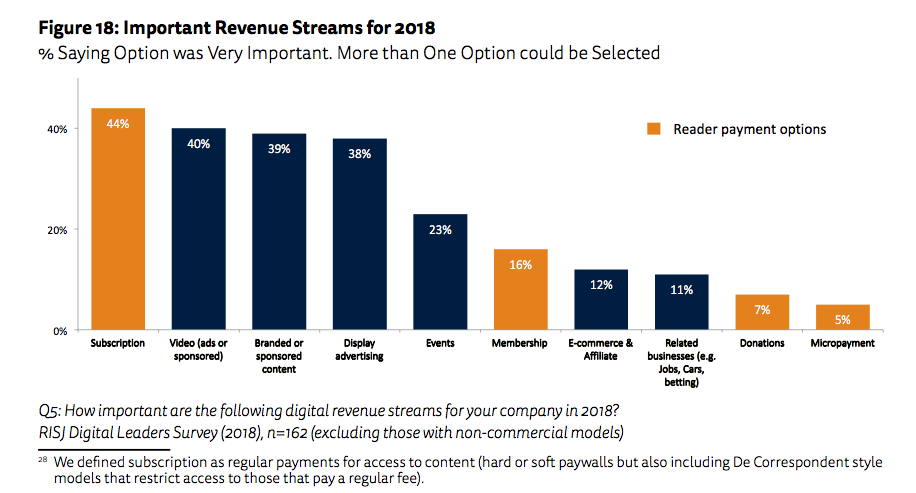Digital technology is changing how people want to consume news and content, and how media businesses must evolve. Publishers will need to change how they package and present stories, how they attract attention, and how they generate new revenues.
The RISJ have made a number of predictions of trends for journalism and media, based on their research primarily among news organisations worldwide. You can download the full RISJ report here.
This is my interpretation of how these trends will affect more specialist media businesses and what you might need to do…
1. Focus on subscriptions and reader revenue
Consumer resistance to paying for online content seems to be softening. News organisations that previously struggled with paywalls are seeing growth in digital subscriptions, such as the Washington Post, who have doubled digital subs to 1 million. And against predictions, The Guardian has built up 500k paying members. Plus recently Wired set up a metered paywall.
A stepping stone to paid subs is registration, and large media owners are building vast email databases. The BBC now requires signup for viewing iPlayer, and has amassed 23m names, while the Telegraph has built up 10m registered users. Registration will ultimately permit more tailored, personalised content as well as a marketing channel for paid subs.
Specialist B2B media have been on this path for some time, but maybe now with news media and broadcasters leading, B2C media will find it easier to construct paid content propositions. Membership or club based offers are gaining popularity in both business and consumer audiences. There are some good examples in this article from FIPP, although I cringe at the word “clubscription”
2. Reduce reliance on digital display advertising
The digital display model is creaking. Many online pure-play media businesses are missing their revenue targets. And the overwhelming majority of mobile digital advertising revenue is going to Facebook and Google, with Amazon the most likely emerging competitor to the “digital duopoly”. So publishers are putting more emphasis on branded or sponsored content created for advertisers, as well as exploring reader revenues.
3. Move away from social platforms towards messaging
Referrals from Facebook to news publishers have been sliding for the last year, and recent statements on changes to the news feed algorithm to favour posts from friends and family will further reduce publisher traffic. Meanwhile Google’s fast loading Accelerated Mobile Pages seem to have driven up referrals for publishers. Add to that the concern about fake news and trust in media content, and many publishers are re-evaluating their use of Facebook.
Visual storytelling on Snapchat and Instagram is growing, with news media such as the New York Times investing in both platforms.
Meanwhile WhatsApp continues to grow and according to RISJ, 23% of readers use messaging apps for news weekly.
So specialist media need to manage their reliance on Facebook for traffic and maybe start experimenting with emerging platforms for new story formats.
4. Shift to audio and voice, more caution on video
News media have rediscovered the “old technology” of podcasts and are also creating audio content for intelligent voice assistants like Amazon Echo and Google Home. Meanwhile they are a bit more cautious on long form video production, as it has proved much more challenging to generate revenues.
Voice search is waiting in the wings, with Google saying that on Android smartphones, over 20% of searches are now via voice.
So maybe specialist media also need to experiment with audio and podcast content, and keep an eye on voice search.
5. Testing AI to enhance workflow and reader experience
News media such as Associated Press are actively experimenting with AI, as detailed in this thorough report.
The most popular use of AI is to improve content recommendations, although there is also interest in automating workflows, ad targeting, dynamic pricing, and helping journalists find stories. AI is also being used to help journalists check facts with services such as Full Fact and Factmata. Associated Press has been testing out AI to create simple templated stories on corporate earnings and sports results. And in the UK, Press Association has been working with Urbs Media to generate localised versions of stories for local news media.
Whilst specialist publishers may feel that AI tools are out of their budget, it is worth watching these experiments as there are likely to be many more services emerging.
6. Growth of smarter mobile devices
Voice enabled devices like Amazon Echo and Google Home are growing fast, with half of US homes expected to own one in 5 years, and over 15,000 skills or apps, including commerce. Tablet sales are stalling, while smartphone usage is continuing to grow, and more phones will incorporate voice search, visual search and augmented reality (AR).
Mobile payments are growing very rapidly in China, with WeChat now at 500m users. Some Chinese mobile news sites have introduced small per article payments. Meanwhile in India, BYJU, an online learning app, has 700k paying subscribers.
As the dominance of smartphones as wallet, computer, entertainment and learning centre continues, specialist publishers need to experiment with new ways to package and sell their content.
What to do next?
This whirlwind of technology innovation can feel overwhelming to the independent media owner. But it will pay to keep monitoring these trends and considering how they can apply to your business.
If you think it would help for us to run a strategic workshop with your team to explore how to interpret these opportunities in your market, do get in touch to have a chat over the phone or over a coffee.
***
Find out more about how we can help
About the author:
Carolyn Morgan has over twenty years experience launching, growing, buying and selling specialist media businesses across print, digital and live events. Carolyn now advises publishers large and small on their digital strategy and writes and speaks on digital publishing strategy.

